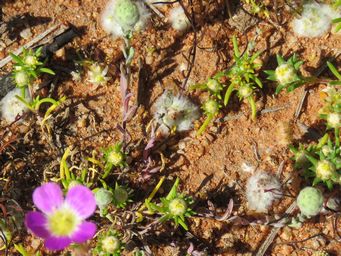Sources used for identification of wildflowers shown on these pages and regions where they occur see Credits
These pages will
feature some of the wildflowers we have photographed in Western Australia, and where possible, identified. If you
are able to help identify further flowers, or correct any I may have wrong, please contact us.
Information given for each species
will give botanical name, known common names, describe the flower, give time of year it flowered, and where it was photographed, and
the areas it occurs in. Names have been matched to Florabase which has also been used to show distribution.
See some
of these wildflower in larger sized photos on our Flickr pages.
Australia So Much to See
Copyright (C) 2013 AustraliaSoMuchtoSee.com. All reights reserved

Andersonia caerulea Foxtails
A small shrub with heads covered in tiny purple stars with blue star shaped flowers in the centre.
Spring
Above
left at Bridgetown and above right at Northcliffe, South West region, Western Australia, and occurs through the South West, Great
Southern and into the Wheatbelt Regions

Andersonia sprengelioides
A small shrub with clusters of five petalled pink to mauve flowers at the tips of the stems.
Broad leaves are layered up the stems, and have an extended point
March
Albany, and found close to the coast from Perth to Esperance,
with scattered occurrences through the Great Southern region and into the Wheatbelt.


Alyxia buxifolia Dysentery Bush, Sea Box, Heath Box, Tonga Bean Wood, Camel Bush, Darljirru
Five petal small white flowers on
a low shrub. Petals have slightly spiral appearance at the end of a orange tube. Spent flowers like candles. Fruit
(not photographed) is in two separate round read pieces, with the lower one turning red first, while upper one is still green.
Spring
Marchagee Nature Reserve (above) and Merredin (at right), Wheatbelt Region, Western Australia and occurs through the Mid
West, Wheatbelt, Great Southern and Goldfields regions


Alyogyne hakeifolia, Red-centred Hibiscus
A large six petaled Hibiscus flower with more cup shaped bloom that other native
Hibiscus species. A large red centre to the flower. The overlapping petals have red on the lower edge of the
petal, creating a spiral effect. Flower colours range with white, yellow and mauve occurring. Growing on a shrub which
may reach up to three metres tall, the bush has long slender cylindrical leaves.
Spring
Seen at Port Gregory, where it may have been
naturally occurring, or planted within its natural distribution area, Mid West region, Western Australia and occurs through the
Mid West, Wheatbelt, Goldfields regions, but excluding most of the South West and Great Southern regions.


Aluta aspera subsp. hesperia
A small low shrub with pale pink blossoms six to eight millimetres across, with around twelve stamens
and a red flower centre. Succulent green foliage consisting of wedge-shaped leaves alternating up the stems, with darker spots
on them.
August
Noorgung Hill, west of Yalgoo, and found through the Mid West and the northern Wheatbelt regions.


Androcalva loxophylla 2011 (formerly Rulingia loxophylla)
A small prostrate plant with tiny yellow flowers of a double layered appearance
with red anthers around the inner flower section. Leaves are much larger than the flowers, wide, and crinkled with an irregular
edge.
August, but can flower at any time of year.
South of Leinster, Leonora Shire, and occurs through the Pilbara and
inland desert regions.
Androcalva luteiflora 2011 (formerly Rulingia luteiflora), Yellow-flowered Rulingia
A double layered geometric appearance on a small
flower, with red behind the stamens. Leaves are wide and crinkled with a jagged edge.
August
Bunjil Rocks, Perenjori Shire
and found through the Pilbara, the inland deserts, Mid West, Wheatbelt and Goldfields regions.


Angianthus milnei, Cone-spike Angianthus
A small egg-shaped cone covered in tiny yellow star flowers around a fluffy ball. Above left
appears to be flowers developing, and above right with evidence of some remaining yellow stars on these balls of fluff. Short succulent
foliage hugging the stems, from a base ring of longer succulent foliage.
August
Mount Magnet shire, Mid West region, Western
Australia. Occurs through the Mid West, Gascoyne and into the Pilbara region.











